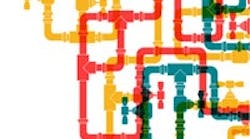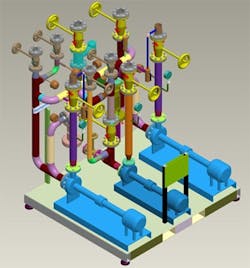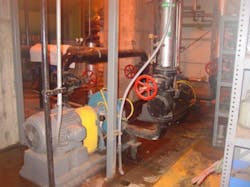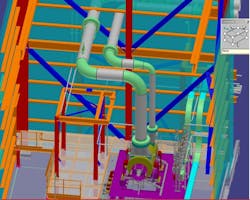Piping loads that can be imposed on machinery nozzles (such as those of pumps, compressors, etc.) should be restrained within certain limits. Piping designers always want higher allowable nozzle loads to simplify piping designs while machinery manufacturers want smaller allowable nozzle loads to ensure good alignment, higher reliability and fewer complaints about operation. Process plant operators place great importance on long-term reliability of equipment and, so, generally should side with the machinery manufacturers. Regardless, it's essential for all parties to agree upon optimum nozzle loads for any machinery package.
Figure 1. This layout typifies piping design for horizontal pumps.
Let's look specifically at nozzle loads for pumps and compressors.Pump nozzle loads. These are specified in the pump's codes and standards (for example, API 610). The API 610 standard covers nozzle loads for horizontal pumps, vertical in-line pumps and vertically suspended pumps for nozzle sizes up to 16 in. (400 mm). For larger pump nozzles, come to an agreement with the vendor about nozzle loads before placing the order. Figure 1 depicts a piping design for horizontal pumps. Figure 2 shows real piping of an electric-motor-driven pump in a process plant. Generally, small pumps not anchored to their foundations can tolerate higher nozzle loads than anchored ones. Allowable nozzle loads for vertical in-line pumps with supports not anchored to the foundation could be twice those of anchored pumps.Compressor nozzle loads. For centrifugal compressors, the API 617 standard specifies the nozzle load limits. However, many purchasers usually ask for two times the API 617 nozzle loads (2×API 617) to make piping design easier. While some machinery engineers and vendors may consider the API nozzle-load values optimum, in many situations piping engineers and stress analysis specialists can't achieve these values. A higher value (particularly 2×API 617) is a good solution to allow piping without expansion joints at nozzles or to avoid very complex piping systems. For special applications with very large differences between operating and ambient temperatures and very large nozzle sizes, it may make sense to specify a nozzle load three times the API 617 values (3×API 617). Figure 3 shows an example of a large compressor piping.Assign relatively low nozzle loads to integrally geared centrifugal compressors or rotating machines primarily designed for low pressures (such as some axial compressors, low-pressure overhung compressors, and machinery with open impellers) that rely upon close radial and axial clearances of rotating components (impeller or rotor assemblies) to machinery casings. For these compressors, allowable nozzle loads above conventional values in the API 617 standard aren't feasible. While the nozzle loads in AP 617 usually can be achieved, the nozzles loads often instead are limited to 0.9×API 617. In any event, come to an agreement with the vendor on suitable nozzle loads before ordering such machines.For screw compressors, the API 619 standard recommends nozzle loads. The nozzle loads of reciprocating compressors are left for the purchaser and vendor to jointly set. Generally, screw or reciprocating compressors come as packages; the purchaser and vendor should agree upon allowable nozzle loads at vendor interfaces.Figure 2. Electric-motor-driven pumps such as this are common at process plants.
Figure 3. Large centrifugal compressors often are piped in this way.
Avoid to the maximum extent possible the use of expansion joints — they are expensive and maintenance-prone. Instead, put in more bends or loops to accommodate expansion. Also, avoid conservative stress analysis. One modern approach is to have the vendor model the entire system (including the piping and the machinery) at the same time. Concurrent modeling can reduce inherent conservatism and could allow the thermal movements to be accommodated correctly by both systems. This may result in a more-flexible combined system and can allow better optimization. Elimination of the expansion joint often can pay for the engineering time needed to remodel, re-evaluate and redesign the entire system. Ideally, include such an optimization-simulation in the vendor scope before the order.
AMIN ALMASI is a rotating equipment consultant based in Brisbane, Australia. E-mail him at [email protected]






